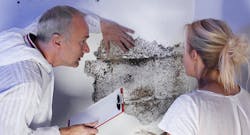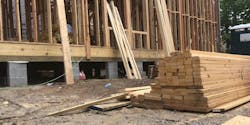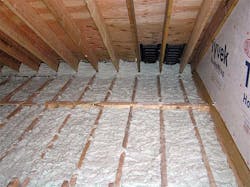Is There Mold in New-Construction Homes?
Is there mold in the new house I just had built for me and my family? This is a question that should be asked more often by more homebuyers because, unfortunately, the answer is almost always yes. Weather, improper storage of materials, and poor construction practices create a perfect storm for mold growth—even in new construction.
As an international mold expert, I am constantly encountering people with major mold issues in their homes. Often the high remediation cost has led people to look toward new construction. Their logic is that a newly built home would never have mold because it doesn’t have a history of water damage. Unfortunately, this is wishful thinking.
Coincidentally, I’ve witnessed mold growth firsthand in my own newly built home while it was under construction, as shown in this photo:
If you take a close look, you’ll see there’s mold all over the framing. If I'd neglected to catch it and bring it to my builder’s attention, I would have undoubtedly had mold in my brand new home from the first day we moved in.
So how does mold occur (and grow) in a home that’s newly built?
Jobsite Materials Storage and Mold Growth
For one, when the lumber that’s being used to build your home is delivered, it is often dropped right on top of the ground. If it is not used in a timely fashion and is exposed to the elements (specifically, rain), lumber sitting in the mud can result in excessive moisture retention in the wood for much longer than 48 hours. This scenario creates the perfect opportunity for mold to grow on the lumber, considering how quickly mold can grow—within 48 hours.
A simple solution would be to deliver the lumber on cribbing that can keep it elevated off the soil. From there, it can be protected from the elements using tarps, until the framers are ready to begin.
RELATED
- The Value of Proper Building Materials Storage
- How to Properly Store and Transport Wood Structural Panels
- Mold Remediation: Telling Fact From Fiction
- Moisture Management to Prevent Mold
- VIDEO: The Quarantine Crawlspace: From Mold to Moisture Management
Moisture During Insulation Installation
The next problem I see is the presence of moisture in the lumber as faming cavities are being insulated. This instance can be especially dangerous if you use spray foam as your preferred method of insulation. If the lumber has a high moisture content, the spray foam will trap that moisture in the framing assembly, which causes another opportunity for mold to grow.
Implementing a dehumidification process to dry out the space properly before installing any insulation or drywall will go a long way toward mitigating mold growth during construction.
Other Potential Moisture and Mold Sources in the Home
Some of the other things to watch out for:
- Spatial separation: Ensure there is separation between conditioned spaces and non-conditioned spaces. I had a client where the garage bays were open to the first-floor living area bays without any separation. This allowed non-conditioned humid air to mix with conditioned cool air and create a dew point on the back of the ceiling. This resulted in mold growth throughout his ceiling on the first floor. The ceiling had to be remediated and from there, structural blocking had to be installed to prevent the exchange of air from the garage to the living space.
- Attic insulation: Ensure that attics are well insulated against the living spaces below to prevent a dew point from developing due to temperate differentials. This is especially important with duct work as you’ll develop condensation around the duct work if it isn’t appropriately insulated. Another key factor is to seal up well around the register boxes and any other penetrations where duct work and other mechanical components enter from a conditioned space into a non-conditioned space.
- Continuous barrier: Check for any tears in the vapor barrier. Inspect the vapor barrier before the slab is poured to ensure the vapor barrier is free of large gaps, holes, or tears. A vapor barrier is supposed to stop water and moisture from intruding into the slab, but it only works if it's perfectly sealed.
If you’re a home builder, I recommend you take a hands-on approach to quality assurance with your trades and subcontractors to mitigate the potential for mold during the construction process. Keep materials protected when stored, inspect the vapor barrier for rips before the foundation is poured, and look out for excessive moisture content in lumber as the home is framed.
Michael Rubino, The Mold Medic, and author of The Mold Medic: An Expert’s Guide on Mold Removal is an authority on mold remediation. As president of All American Restoration, with locations in New Jersey and Florida, Rubino specializes in working with people who are immunocompromised or have acute and sustained reactions to mold exposure. He is a council certified Mold Remediator by IICRC and ACAC and a contributing member, sponsor, and speaker for the Indoor Air Quality Association. Connect with Michael on Facebook @AllAmericanRestorationTM and Instagram @TheMoldMedic.



